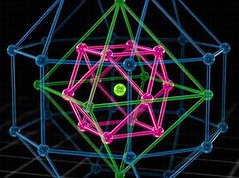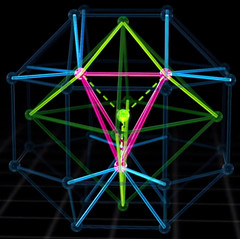 澳洲和台灣科學家發現了一種新的分子,有機會突破氫燃料電池車發展的主要障礙──安全點燃易燃的氫氣。
澳洲和台灣科學家發現了一種新的分子,有機會突破氫燃料電池車發展的主要障礙──安全點燃易燃的氫氣。
這個暱稱「中華謎樣分子」(Chinese Puzzle molecule)的新物質以28銅15氫化物為核,包在二硫代氨基甲酸中。
科學家說,這個新分子是進一步了解氫的新途徑,包括如何讓它進出汽車的燃料電池系統,以及如何穩定安全地儲存氫。
許多汽車製造商準備明年把氫燃料電池車推向更廣大的市場,包括豐田FCV、雪佛蘭Equinox燃料電池版、本田FCX Clarity、現代IS35燃料電池版和賓士B-Class燃料電池版。
燃料電池將氫原子的一顆電子從其單顆質子分離,用這顆電子製造出能夠供電給電動車馬達的電流。
但是當有氧存在的時候,氫會著火爆炸,比汽油更易燃。點燃氫所需的能量僅是點燃汽油的十分之一。人手指上靜電引起的火花就足以點燃氫。
理想的環境下,燃料電池液態氫罐中不該有氧存在,但是只要一點點的空氣就足以汙染氫罐。萬一氫洩漏出,將會與空氣中的氧接觸。
「28銅15氫化物」是東華大學化學系主任劉鎮維研究團隊合成的新分子。其化學結構測定則是澳洲核科學和技術組織 (ANSTO) 以晶體工具KOALA完成。
ANSTO成員、布拉格研究所晶體學家Edwards博士說,「此研究顯示,將某些特定銅化合物和硼氫化物混和 (硼氫化鈉或BH4) 能創造出我們新發現的『中華謎樣分子』── 氫化物和銅互相交疊,外面包覆著保護性的分子層。」
「我們用先進的KOALA儀器辨識出這個分子的核心實際上包含不少於15個氫化物,比我們預期的8個多了近一倍。」
「這個新分子有著前所未見的金屬氫化物核心,和已知的氫化物截然不同、更加穩定。實際上,『中華謎樣分子』 不同於其他的氫化物,在空氣中相當穩定。因此我們認為值得深入研究其特性和潛力。」
研發配電組件一直是氫燃料電池作低碳汽車動力來源的四大障礙之一,而此發現,可讓配電組件的研發往前邁進一步。Edwards補充說,「這並不是說氫動力汽車即將實現。這個發現可能讓我們在這條路上前進了一步,但我們不知道這條路還有多長。這個研究所說的是氫化物可能是讓氫進出燃料系統並且穩定安全儲存的方法。」
對替代能源的開發深具意義
 東華大學指出,劉鎮維實驗室所合成出的銅金屬氫化物(copper hydride),結構中含有大量氫負離子(hydride),照射太陽光或是加熱至80℃就可以釋放氫氣,再加入氫負離子之後又可以將之穩定的儲存在結構中並且繼續循環利用,由於氫氣作為燃料不會造成環境汙染,因此這項研究成果對替代能源的開發深具意義。
東華大學指出,劉鎮維實驗室所合成出的銅金屬氫化物(copper hydride),結構中含有大量氫負離子(hydride),照射太陽光或是加熱至80℃就可以釋放氫氣,再加入氫負離子之後又可以將之穩定的儲存在結構中並且繼續循環利用,由於氫氣作為燃料不會造成環境汙染,因此這項研究成果對替代能源的開發深具意義。
此金屬氫化物主要以銅金屬為主,銅相較其他貴金屬便宜,在成本上具有優勢,其核心由銅和氫所構成的多面體骨架像是中國象牙球一樣的層狀結構,層與層之間靠著銅和氫的作用力維持,並利用特殊的配位基保護銅氫化物的核心,穩定性高於其他已知的金屬氫化物(metal hydride)。
為瞭解金屬與氫之間的作用力,必須鑑定氫原子的準確位置,由於氫的電子數目太少,X光繞射(X-ray diffraction)實驗無法有效鑑定氫原子在化合物中的準確位置,先後由法國理論計算團隊算出銅和氫的位置,並在澳洲團隊的協助下做中子繞射(neutron diffraction)實驗,最後定出氫的原子核準確位置,對於將來在銅金屬和氫原子之間作用力的研究有很大的幫助。
本研究是與法國理論計算團隊及澳洲中子設施團隊跨國合作,結果發表在德國化學期刊Angewandte Chemie(John Wiley & Sons, Inc., IF 13.734),同時獲選該期刊當期封面照片。(資料來源:東華大學新聞稿)
Australian and Taiwanese scientists have discovered a new molecule that may help resolve one of the barriers to development of hydrogen fuel cell cars – how to safely fuel up with the highly explosive gas.
The new molecule, nicknamed the Chinese Puzzle Molecule, is a 28copper15hydride core wrapped in dithiocarbamate.
Scientists say that the new molecule puts us on a path to better understanding hydrogen, how to get it in and out of a vehicle’s fuel cell system, and how to store it in a stable, safe manner.
Several automakers are poised to bring hydrogen fuel cell cars to a wider market next year, including: the Toyota FCV, the Chevrolet Equinox Fuel Cell, Honda FCX Clarity, Hyundai is35 Fuel Cell and the Mercedes-Benz B-Class F-Cell.
A fuel cell separates the single electron in a hydrogen atom from the single proton and uses the electrons to produce a stream of electricity that can then power the motor in an electric vehicle.
But in the presence of oxygen, hydrogen can catch fire and explode, and it burns more easily than gasoline. Hydrogen requires only one tenth as much energy to ignite as gasoline does. A spark of static electricity from a person’s finger is enough to set it off.
Ideally, no oxygen should be present in the liquid hydrogen tanks in a fuel cell vehicle, but trace amounts of air may contaminate the hydrogen supply. If the hydrogen should escape, it will come into contact with the oxygen in air.
“28copper15hydride” was synthesized by a team led by Professor Chenwei Liu from the National Dong Hwa University in Taiwan.
The chemical structure determination was completed by the team at the Australian Nuclear Science and Technology Organisation (ANSTO) using the crystallography tool KOALA.
ANSTO’s Dr. Edwards, a chemical crystallographer at the Bragg Institute, says, “This study revealed that mixing certain copper (Cu) compounds with a hydride of boron (borohydride or (BH4)) – created our newly discovered “Chinese Puzzle molecule” with a new structure that has alternating layers of hydride and copper wrapped in an outer shell of protecting molecules.”
“Using our leading KOALA instrument – we identified that this molecule actually contained no less than 15 hydrides in the core – which is almost double the eight we were expecting.”
“This new molecule has an unprecedented metal hydride core – it is definitely different and much more stable than many previous hydride compounds, in fact it is stable in air, which many others are not,” Edwards said. “So, we see there is probably much more yet to learn about the properties, and potential of hydride.”
The discovery puts us one step further along a path to developing distribution infrastructure – one of four obstacles to hydrogen fuel-cell technology as a viable power source for low-carbon motor vehicles.
“No one is claiming hydrogen-powered cars are imminent,” she said. “Perhaps this puts us a step further down the road, but we don’t know how long the road is. What this research shows is hydrides may yet help us get hydrogen in and out of a fuel system, stored in a manner which is stable and safe.”
※ 全文及圖片詳見:ENS






